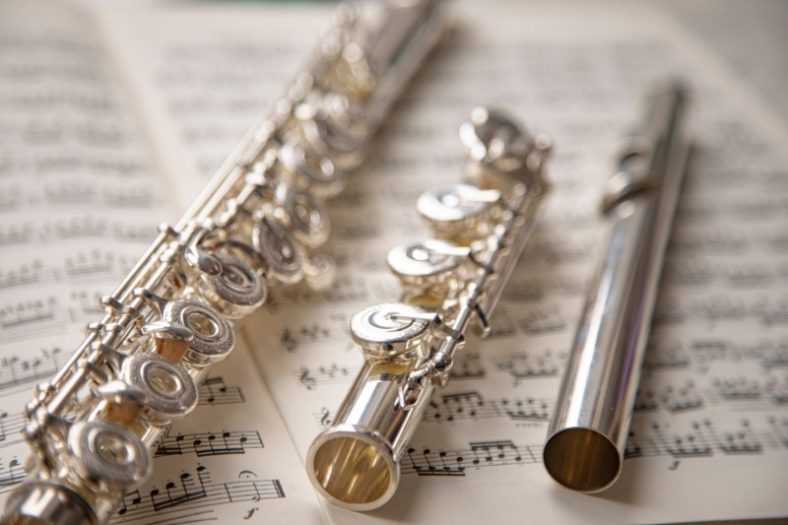Is The Flute Hard to Learn?

The flute is a medium-level instrument to learn. But, as with most instruments, it is challenging to master playing the flute with advanced techniques and complex melodies. With a good amount of quality effort and the right help, everyone can play the flute at a high level.
Contents
How Hard Is It to Learn the Flute?
The flute is a medium-level instrument to learn as the finger positions, the maintenance of the instrument, staying motivated, and finding different resources are quite easy. However, the embouchure, which means the mouth position, producing consistent tones, and physical demands to play the instrument make it quite challenging, especially in the beginning.
Finger Positions
The finger positions of the flute for producing different notes may appear complicated, however, they are pretty basic once you learn them. The high amount of keys may be hard to memorize at first, but the order is quite easy to learn. Also, the flute uses the same positions as the soprano recorder that most of us are familiar with from school.
The fingering positions are regarded as the easiest part of learning to play the flute by many players. So, you do not need to worry about memorizing complex fingerings and positions.
Maintenance Of The Instrument

The maintenance of an instrument is one of the crucial parts which can make the learning process easy or hard. Fortunately, flutes are some of the easiest instruments in terms of maintenance. Rubbing alcohol from time to time and maybe some fingerpad paper is more than enough to keep your instrument clean and ready.
Poorly maintained instruments make the learning process quite challenging as it is not easy to get used to playing an instrument with sticking keys or loose pads. You will have to get into the habit of regular repair if you want your practice sessions to be efficient.
Properly maintaining your instrument is highly important. Besides, as flutes are woodwind instruments, it means that bacteria issues are present. You will have to clean and maintain your instrument regularly. Luckily, flutes are easy to clean.
Staying Motivated and Finding Resources
As playing your first melodies with the flute is relatively easy after you get the embouchure right, students get motivated quite easily to practice more and more. As it is a popular instrument, finding resources to practice and learn new melodies are also quite easy. You won’t be playing the same exercises again and again.
For instance, the violin is one of the hardest instruments to learn, and sometimes you find yourself stuck in the same exercise for weeks. This is not the best for impatient people as they can give up because they get bored often.
But flutes are quite easy, especially in the beginning. You will find yourself playing lots of different melodies, which gets you more motivated to learn and play. The difficult part comes with the advanced techniques when you feel quite comfortable with the basic melodies.
The learning process when playing the flute is quite steady. You always feel you are improving all the time, which is the key to feeling motivated. And you will see there are lots of resources like melodies, lessons, and tips and tricks everywhere to get you going.
Embouchure
The hardest part of the flute is probably the embouchure, which means the mouth position. It is one of the biggest challenges in the beginning, as the right embouchure shape for playing the flute depends on the player’s mouth shape and lip thickness. The right shape is a tight and small circle with the lower lip a bit farther than the upper.
The embouchure shape for the flute is different from the rest of the wind instruments. The brass instruments require the players to buzz their lips, while the reed instruments like the saxophone require the players to close their lips around a mouthpiece and blow. But the flute is quite different.
The upper lip should be placed slightly closer than the lower lip creating a tight circle before sending a stream of air into the mouth hole towards the lip plate on the head joint. If you can blow the air to the right spot at the right angle, the blown air will be split in half, causing the necessary vibration.
Producing Consistent Tones
When you learn the embouchure shape and can produce good-quality sound with the flute, the challenge is to produce good-quality sound consistently when changing notes. The blowing angle and the embouchure shape slightly differ for higher and lower notes, making it quite challenging to play in the beginning.
With practice, you can get used to the techniques easily, but it will be a challenge at first. However, this is not a huge deal as you will see you can get used to the angles and shapes quite fast and easily.
Physically Demanding Instrument
The biggest issue with the flute, if you want to play advanced melodies, is that the flute is a physically demanding and tiring instrument. You will have to learn to control your breath pretty well and need to practice different breathing techniques to play advanced techniques and complex melodies.
The flute often plays the main melody in ensembles, bands, and orchestras. You will be playing quite complex melodies with advanced techniques. For this, you will need to use your breath pretty efficiently and learn how to control your breath to give the right dynamics.
How Long Does it Take to Learn the Flute?

You can start playing the flute at a decent level in a few months, but if you want to master the instrument, you will need years of dedication. For a decent level of proficiency, you will need around 2 to 3 years of half-an-hour practice every day.
The process can be slower and faster depending on your dedication and motivation. If you practice half an hour each day, you will be playing a lot of basic yet different melodies in 6 months.
Which Type of Flute Should You Get?
The first flute you purchase should be beginner-friendly, which means easy-to-play, lightweight and durable. The silver-plated flute with closed holes with an E mechanism (Split E) and a C foot joint are easier to play and re-sell later.
There are many different flute variations, such as open holes, E mechanism, C# trill keys, D# roller, B foot joint, and silver variations. But the silver-plated flute with closed holes, E mechanism, and C foot joint is the most traditional layout, which I recommend you to start with.
Later, when you feel comfortable with playing the instrument, you can explore the new layouts more suited for your potential style.
The Best Way to Learn the Flute
There are many ways you can learn the flute. You can take private lessons to progress solidly and quickly, or you can go solo and use different online lessons, apps, and videos. Many websites offer helpful charts and cheat sheets on mastering flute notes and techniques for beginners.
If you have the budget, the best way is to have a mentor that can correct your mistakes immediately in the beginning. Learning a technique improperly and engraving it into muscle memory is one of the biggest mistakes that beginners make. Later, these habits are much harder to correct, so going solidly is the best way to build a good base technique.
However, private lessons may be expensive for most people. So learning alone and meeting with a mentor from time to time to get your technique checked might be a good idea. Meanwhile, you can use websites, apps, and YouTube videos as your primary learning resource.
5 Tips To Learn The Flute
- Practice, practice, practice: The key to learning a new skill is consistent practice with many repetitions. This way, you can build the fluidity, speed, and confidence required to master techniques and complex melodies. Techniques such as tonguing or slurring and using different articulations require many hours of practice to apply correctly.
- Don’t rush: As you start to learn to play the flute, you will see you can go fast by learning different techniques, notes, and fingering positions. However, you should go one by one, mastering a note, technique, or position before changing to another.
- Be patient: The first steps when learning to play the flute requires a bit of patience as learning the right embouchure shape and posture can be challenging. Try to be patient and often practice in the first steps to get over this phase, as the rest will be much easier, and you will feel motivated when you start playing some melodies.
- Do not forget the maintenance: You should maintain your instrument well and rub it with alcohol after each playing session to keep it well and clean. Also, you should learn how to assemble and disassemble your flute properly for better longevity.
- Play every day: For building the correct technique, you need to be consistent with your instrument. Playing it every day will create the necessary habit to progress with your technique and musical knowledge solidly and quickly.
How Does a Flute Work?
Flutes are woodwind class musical instruments that produce sound when a column of air is blown through the hole into the instrument, which creates a vibration inside the instrument. The player changes the pitch of the note by changing the length of the instrument’s body by opening or closing the holes.
Conclusion
The flute is an amazing instrument that is relatively easy to learn if you get past the first few steps of learning the embouchure shape and blowing angle. However, it will require some patience in the first month or two. Afterward, it is quite straightforward to progress with your instrument and play new melodies.





